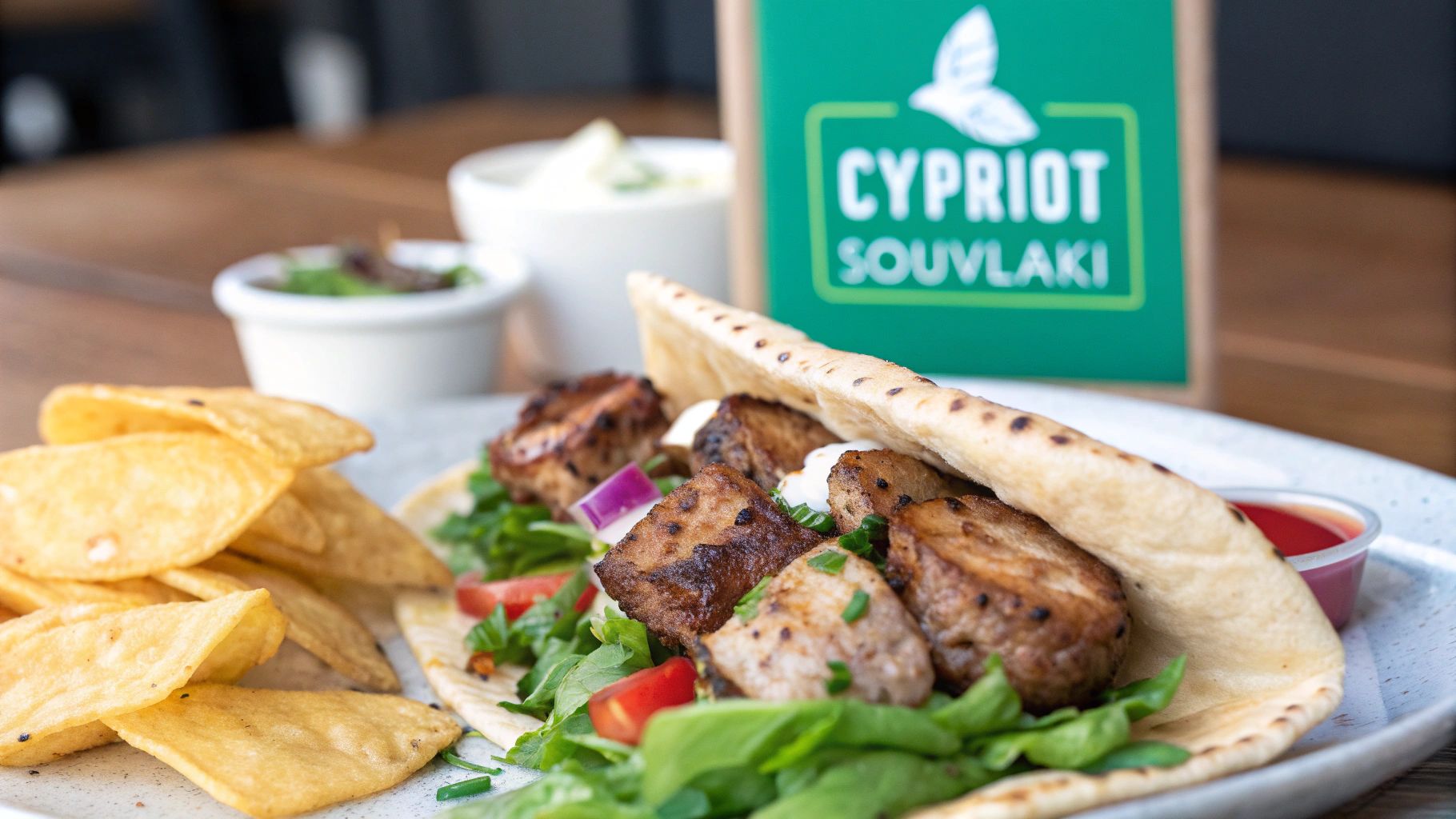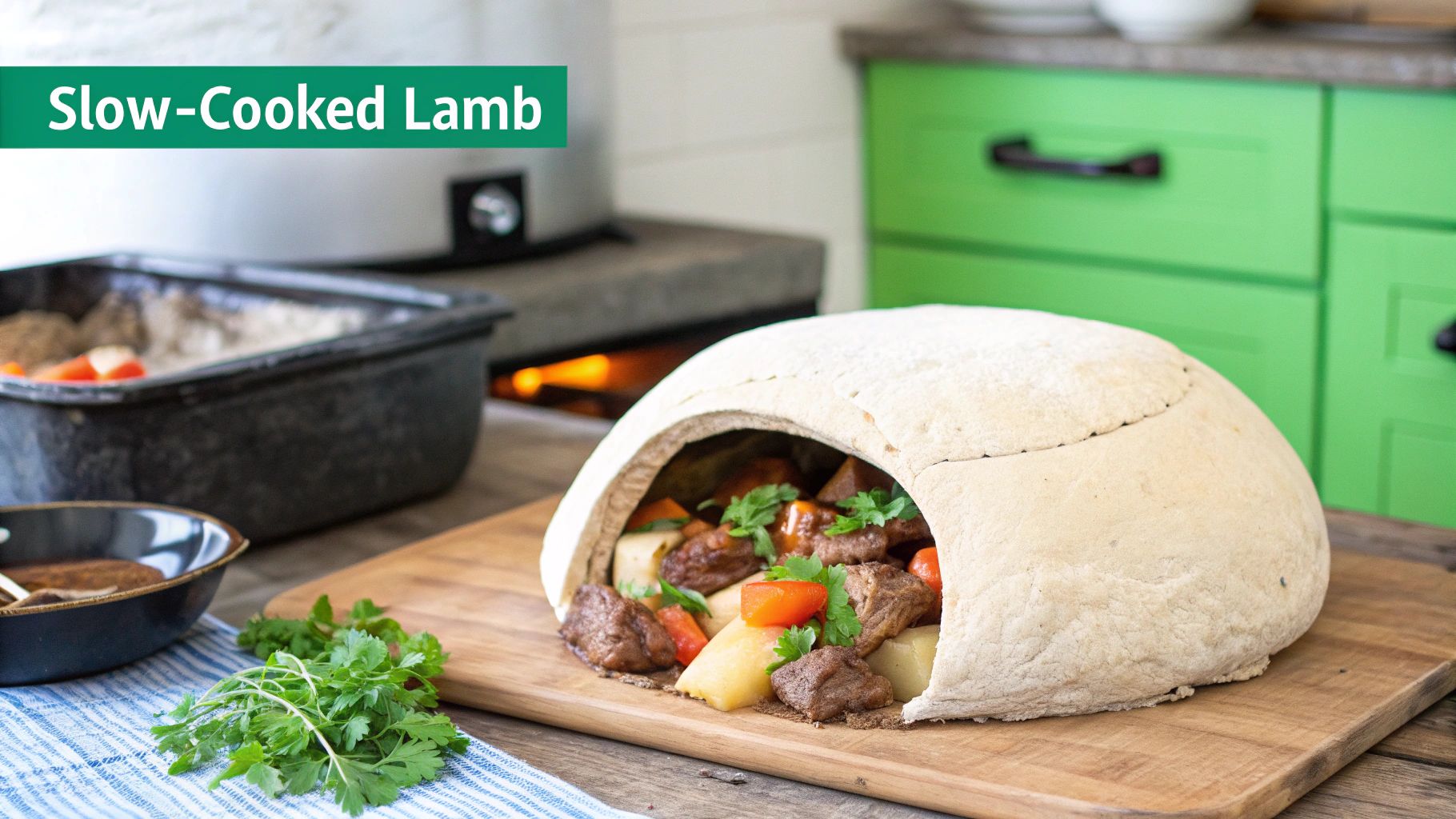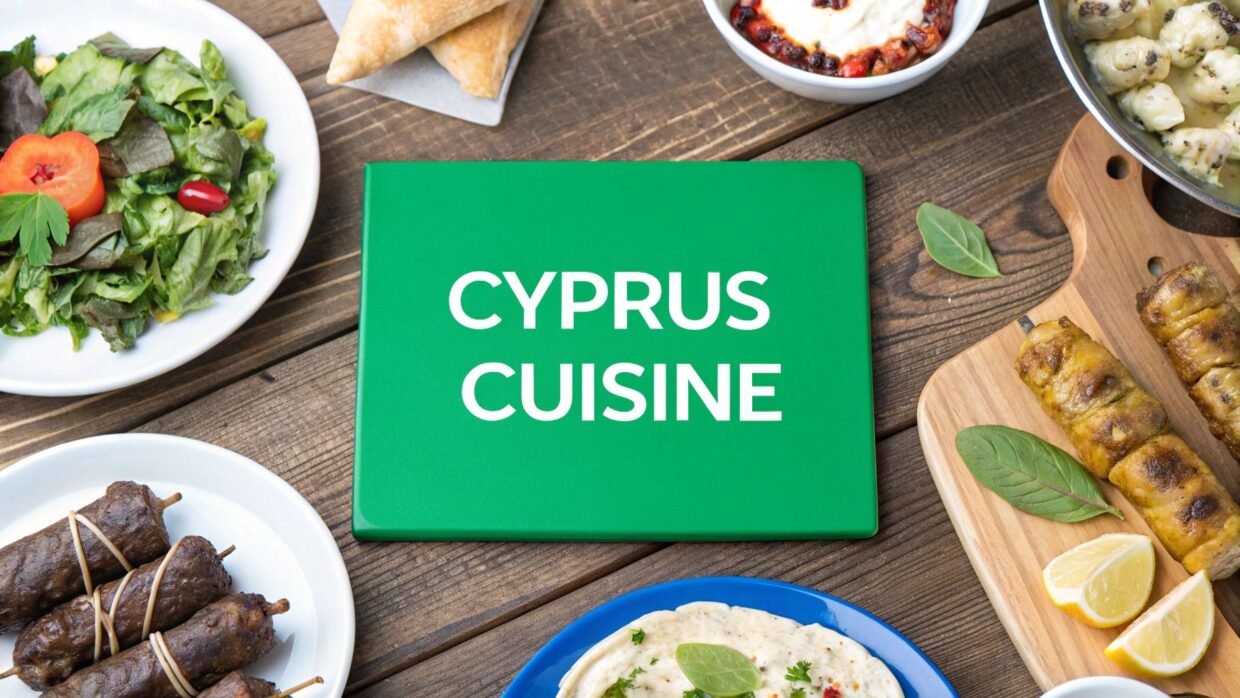Welcome to Cyprus, an island where every meal tells a story steeped in centuries of history. While famous for its stunning coastlines and ancient ruins, the true heart of the island lies in its rich and flavourful cuisine. The culinary landscape is a vibrant tapestry woven from Greek, Turkish, and Middle Eastern influences, creating dishes that are uniquely Cypriot. Forget generic holiday fare; we are about to embark on an authentic gastronomic adventure.
This guide delves into the essential traditional Cyprus foods that form the foundation of the island's culinary identity. We will explore the must-try dishes that every visitor should seek out, moving beyond the obvious tourist traps to uncover authentic flavours. You will learn not just what to eat, but also the cultural significance behind these beloved recipes and practical tips on where to find the best examples, from bustling city tavernas to quiet mountain villages.
From sizzling, charcoal-grilled meats and the world-renowned squeaky cheese to slow-cooked lamb that melts in your mouth, this list is your definitive starting point. Prepare to discover the dishes that define this Mediterranean paradise, ensuring your visit is as delicious as it is memorable. Let's explore the seven iconic tastes you simply cannot leave Cyprus without experiencing.
1. Souvlaki
No culinary tour of the island would be complete without savouring its national dish, Souvlaki. This beloved staple is far more than just grilled meat in a flatbread; it's a cornerstone of Cypriot food culture. Traditionally, small, tender chunks of pork, chicken, or lamb are marinated in a flavourful blend of local wine, olive oil, and herbs before being skewered and grilled to perfection over hot charcoal.

The grilled meat is then tucked into a large, warm Cypriot pita, which is characteristically thin and has a pocket, unlike its thicker Greek counterpart. It’s generously filled with a fresh salad of chopped cucumber, tomatoes, white cabbage, and parsley, often with a drizzle of tangy tzatziki. This combination makes it one of the most iconic traditional Cyprus foods you can experience.
How to Enjoy Souvlaki Like a Local
To get the full, authentic experience, consider these tips:
- Ask for 'Mixed': Can't decide between meats? A 'mixed' souvlaki often combines pork skewers (souvlakia) with sheftalia (spiced sausage parcels), offering a fantastic contrast of textures and flavours in one pita.
- Add Halloumi: For a truly Cypriot twist, ask for grilled halloumi cheese to be added to your pita. Its salty, squeaky texture perfectly complements the smoky meat.
- Go 'Village-Style': Requesting a 'village-style' (choriatiki) preparation often means you'll get more traditional seasoning, sometimes with just salt, oregano, and a squeeze of lemon, letting the quality of the meat shine through.
- Pair it Perfectly: A cold local beer, like KEO or Leon, is the classic accompaniment. Alternatively, a glass of crisp Cypriot Xynisteri white wine cuts through the richness of the meat beautifully.
Where to Find the Best Souvlaki
While you can find souvlaki stands almost everywhere, the quality can vary significantly. For the best experience, venture beyond the main tourist strips. Local tavernas in villages or neighbourhood 'souvlatzidika' (souvlaki shops) are your best bet for authenticity and quality. In Nicosia's old town, street vendors serve up classic versions perfect for a quick lunch. For a more sit-down experience, Kalamies Beach Restaurant in Protaras is famed for its beachside souvlaki, while many establishments in Limassol pride themselves on traditional preparation. For more recommendations, you can find a curated list of the best restaurants in Limassol.
2. Halloumi
No list of traditional Cyprus foods would be complete without its most celebrated export, Halloumi. This unique, semi-hard cheese is a true symbol of the island's culinary identity, traditionally crafted from a mixture of goat's and sheep's milk. Its high melting point allows it to be grilled or fried to a beautiful golden-brown, creating a delightfully crispy exterior while the inside remains firm with its signature squeaky texture.

With a heritage stretching back centuries and a Protected Designation of Origin (PDO) status from the EU, Halloumi is deeply woven into Cypriot culture. It can be enjoyed fresh, where its salty, mint-infused flavour shines, or cooked, where its savoury character intensifies. Its versatility makes it a beloved ingredient in countless dishes, from simple appetisers to hearty main courses.
How to Enjoy Halloumi Like a Local
To truly appreciate this iconic cheese, try it the way Cypriots do:
- Pair with Watermelon: The most classic summertime combination is chilled, fresh halloumi served alongside sweet, juicy watermelon. The contrast of salty and sweet is the quintessential taste of a Cypriot summer.
- Grill it Perfectly: For the best results, slice the halloumi into 1cm thick pieces and grill it over medium-high heat for just 2-3 minutes per side. You’re looking for a crisp, golden crust, not a melted puddle.
- Enjoy it in a Sandwich: A popular local snack is grilled halloumi and lountza (smoked pork loin) tucked into a warm pita or village bread, often with fresh tomato and cucumber.
- Try it with a 'Spoon Sweet': For a more unusual but traditional pairing, try a small piece of fresh halloumi with a syrupy 'spoon sweet' (glyko tou koutaliou), such as walnut or cherry, for a delicious sweet-savoury bite.
Where to Find the Best Halloumi
Authentic, traditionally made halloumi is a world away from mass-produced versions. For an authentic taste, seek out artisanal producers in villages like Alambra, where local cooperatives craft exceptional varieties. Many family-run dairies, such as Pittas Dairy Products, have been upholding traditional methods for generations. In restaurants, you'll find it served as a signature appetiser across the island; Sardeles Fish Tavern in Larnaca, for instance, is known for its perfectly grilled halloumi starter that showcases the cheese's simple brilliance.
3. Kleftiko
A dish steeped in history and folklore, Kleftiko is an essential experience for anyone seeking authentic traditional Cyprus foods. The name translates to 'stolen meat', harking back to a time when rural thieves would cook pilfered lamb or goat in sealed, hidden earth ovens to avoid being caught by the smoke. This ancient cooking method has evolved, but the principle remains: meat, typically a large joint of lamb, is slow-cooked for hours with potatoes, onions, and fragrant Mediterranean herbs like bay leaves and oregano until it is so tender it falls away from the bone.

The magic of Kleftiko lies in its slow, gentle cooking process. Traditionally baked in a 'fourno', a sealed clay oven, all the juices and aromas are locked in, allowing the meat to baste in its own flavours. The result is a succulent, flavourful, and incredibly moist dish that embodies the rustic, hearty nature of Cypriot mountain cuisine. It's often served simply with lemon wedges and a side of bulgur pilaf or a fresh village salad.
How to Enjoy Kleftiko Like a Local
To truly appreciate this celebrated dish, keep these local customs in mind:
- Order in Advance: True Kleftiko takes at least four to six hours to cook. Many traditional tavernas require you to order it a day in advance, so it's always wise to call ahead and check.
- Embrace the Simplicity: Don't expect complex sauces. The beauty of Kleftiko is in the pure, unadulterated flavour of the lamb, enhanced only by herbs and its own juices. A simple squeeze of fresh lemon is all it needs.
- Make it a Sunday Meal: In Cyprus, Kleftiko is often the centrepiece of a large Sunday family gathering or a special celebration like Easter. Enjoying it in a group setting adds to the authentic experience.
- Pair it Perfectly: The rich, deep flavours of the lamb call for a robust red wine. A local Cypriot Maratheftiko is the ideal partner, though the famous sweet Commandaria wine also offers a unique and traditional pairing.
Where to Find the Best Kleftiko
For the most authentic Kleftiko, you must seek out establishments with a proper clay oven. In Paphos, Stou Kir Yianni is a legendary taverna famous for its exceptional Sunday Kleftiko, drawing locals from all over the district. If you find yourself exploring the Troodos Mountains, a visit to Platanos Tavern in the village of Agros will reward you with a traditional mountain-style version that is second to none. Many family-run tavernas across the island have their own treasured recipes, so don't hesitate to ask if their Kleftiko is cooked in a traditional 'fourno'.
4. Meze
If souvlaki is the national dish, then the meze is Cyprus's national dining experience. More than just a meal, a Cypriot meze is a culinary marathon, an elaborate feast of 20 to 30 small dishes served in a specific progression. It begins with cold appetizers and salads, moves on to hot dishes like grilled halloumi and lountza, and culminates with a grand finale of charcoal-grilled meats or fresh seafood. This structured, comprehensive meal is a true celebration of the island’s diverse culinary heritage.

Unlike the more casual meze platters found elsewhere in the Mediterranean, the Cypriot version is a full-course affair that can last for hours. Each dish, from tahini and taramasalata to slow-cooked kleftiko and sheftalia, showcases local ingredients and time-honoured cooking techniques. Indulging in a meze is one of the most immersive ways to explore the full spectrum of traditional Cyprus foods, offering a taste of everything the island has to offer in one sitting.
How to Enjoy Meze Like a Local
To make the most of this gastronomic journey, keep these local tips in mind:
- Arrive Hungry: This is non-negotiable. A true meze is an enormous amount of food; come with a completely empty stomach and be prepared to allow a full evening for the experience.
- Pace Yourself: The biggest mistake is filling up on the delicious bread, olives, and dips that arrive first. These are just the opening act. Savour them, but save plenty of room for the main events to come.
- Specify Your Preference: Most tavernas offer a choice between a meat meze (kreas meze) and a fish meze (psari meze). Decide what you're in the mood for and be clear when ordering.
- Trust the Locals: The best meze experiences are often found away from the tourist hubs. Ask for recommendations and seek out family-run tavernas where the recipes have been passed down for generations.
Where to Find the Best Meze
For an authentic meze, the setting is just as important as the food. Militzis Restaurant in Larnaca is legendary for its comprehensive, traditional meze served in a rustic setting. For an exceptional fish meze with a view of the harbour, Psarolimano Fish Tavern, also in Larnaca, is a top choice. In Limassol, Monte Cristo Restaurant beautifully combines traditional flavours with a more modern presentation, offering a refined meze experience. To dive deeper into this culinary tradition, you can discover more about Cypriot Meze and other local dishes.
5. Commandaria Wine
Steeped in history, Commandaria is not just a drink but a liquid treasure, recognised as the world's oldest named wine still in production. Its legacy dates back over 800 years, famously dubbed the "wine of kings and the king of wines" by Richard the Lionheart. This exquisite sweet dessert wine is a protected designation of origin product, crafted exclusively from indigenous Xynisteri and Mavro grapes grown in 14 designated villages on the slopes of the Troodos Mountains.
The unique production process involves sun-drying the grapes after harvest to concentrate their sugars and flavours. The juice is then fermented and aged in oak barrels for at least two years, resulting in a complex, amber-coloured wine. Its rich palate reveals notes of honey, raisins, figs, and spices, making it a quintessential part of the island's traditional Cyprus foods and a perfect conclusion to any meal.
How to Enjoy Commandaria Like a Local
To appreciate this historic wine fully, consider the following suggestions:
- Serve it Right: Commandaria is best served slightly chilled, between 8-10°C, in small dessert wine glasses to concentrate its aromatic bouquet.
- Perfect Pairings: Its sweetness and complexity pair beautifully with strong, aged cheeses like halloumi or anari. It is also an exceptional accompaniment to rich chocolate desserts, nuts, or dried fruits.
- Visit the Source: For an unforgettable experience, travel to the 'Commandaria' region villages like Omodos or Koilani, especially during the harvest season. You can learn more about this by exploring some of the available Cyprus wine tours.
- Proper Storage: If you take a bottle home, store it horizontally in a cool, dark place to preserve its quality and allow it to age gracefully.
Where to Find the Best Commandaria
You can find Commandaria in most supermarkets and wine shops across Cyprus, but for a more authentic taste, seek out specific producers. Major producers like KEO and ETKO offer widely available and consistent quality. For a more artisanal approach, boutique wineries such as Zambartas Winery are creating exceptional modern expressions of this ancient wine. A visit to the Cyprus Wine Museum in Erimi also provides a fantastic overview and tasting opportunities.
6. Koupepia (Stuffed Vine Leaves)
A beloved component of any Cypriot meze, Koupepia are delicate parcels of flavour that showcase the island's resourcefulness and connection to its agricultural roots. These tender vine leaves are meticulously stuffed with a savoury filling of minced pork or beef, rice, fresh tomatoes, onions, and a fragrant mix of local herbs, most notably mint and parsley. They are then gently simmered in a broth of tomato, olive oil, and lemon juice until they are incredibly tender.
What sets the Cypriot version apart from its Mediterranean cousins, like the Greek dolmades, is the heartier, meat-forward filling and the warm serving temperature. Often prepared in large batches for family gatherings and festive occasions, Koupepia are a true labour of love and a quintessential example of traditional Cyprus foods that bring people together.
How to Enjoy Koupepia Like a Local
To appreciate these delicious parcels to the fullest, try them the Cypriot way:
- Add a Dollop of Yoghurt: The cool, tangy creaminess of thick Greek-style yoghurt perfectly cuts through the richness of the filling. A simple dollop on the side is the most common accompaniment.
- A Squeeze of Fresh Lemon: While lemon is used in the cooking process, an extra squeeze just before eating brightens all the flavours and adds a fresh, zesty finish.
- Don't Just Eat One: Koupepia are designed to be enjoyed as part of a larger spread. They are a star player in a meze platter, so savour them alongside other dishes rather than as a standalone meal.
- Pair with Zivania: For an authentic local pairing, enjoy Koupepia with a small glass of Zivania, the potent Cypriot pomace brandy. Its strength complements the savoury filling surprisingly well.
Where to Find the Best Koupepia
The very best Koupepia are often found in family-run tavernas where recipes have been passed down through generations. For a legendary experience, visit Zanettos Tavern in the old town of Nicosia, renowned for its traditional meze that prominently features a time-honoured koupepia recipe. You will also find them served during special events like the Cyprus Wine Festival, where they are showcased as a representative dish of the island's culinary heritage. Many village tavernas in the Troodos Mountains also pride themselves on their authentic, home-style Koupepia, offering a taste that is hard to replicate.
7. Loukoumades
For those with a sweet tooth, Loukoumades are an unmissable treat and a quintessential part of Cypriot celebratory culture. These delightful honey puffs are small, round doughnuts made from a simple yeast dough. They are deep-fried until perfectly golden and crispy on the outside while remaining light and airy on the inside. The magic happens when they are immediately drenched in a fragrant honey syrup, often infused with cinnamon and a hint of orange zest.
With a history stretching back over two millennia, Loukoumades are one of the oldest recorded desserts in the Mediterranean. They are deeply woven into the fabric of Cypriot life, commonly served at festivals, religious fairs, and family gatherings. This ancient sweet is one of the most beloved traditional Cyprus foods, offering a taste of history in every bite.
How to Enjoy Loukoumades Like a Local
To savour this dessert in the most authentic way, keep these tips in mind:
- Eat Them Fresh: Loukoumades are at their absolute best when served piping hot, straight from the fryer. This ensures the perfect contrast between the crispy exterior and the soft, fluffy interior.
- Add Toppings: While the classic honey and cinnamon is divine, many modern vendors offer extra toppings. A sprinkle of crushed walnuts or a scoop of vanilla ice cream can elevate the experience.
- Look for Festival Stalls: The most authentic Loukoumades are often found at village festivals (panigiria) or major events like the Limassol Carnival. The aroma alone will guide you to the nearest vendor.
- Pair with Coffee: A strong, traditional Cypriot coffee is the perfect partner for these sweet puffs, as its slight bitterness beautifully balances the syrupy sweetness of the dessert.
Where to Find the Best Loukoumades
You can find Loukoumades all over the island, but for a truly memorable experience, seek them out at cultural events. The annual festival at Panagia Chrysopolitissa Church in Paphos is renowned for its traditional preparations. In Limassol, street vendors do a roaring trade during the Carnival, serving them fresh to revellers. For a more contemporary take, dedicated dessert parlours like Loukoumades Ktiston in Nicosia offer both classic and modern variations, making it a must-visit spot for any dessert enthusiast.
Traditional Cyprus Foods: Key Attributes Comparison
| Item | Implementation Complexity 🔄 | Resource Requirements ⚡ | Expected Outcomes 📊 | Ideal Use Cases 💡 | Key Advantages ⭐ |
|---|---|---|---|---|---|
| Souvlaki | Moderate – grilling and marinating required | Moderate – quality meat, pita, and fresh salad | Filling, flavorful street food meal | Casual dining, street food, festivals | Large portions, customizable, affordable |
| Halloumi | Low – can be grilled or fried simply | Moderate – quality cheese needed | Versatile ingredient, distinctive cheese | Appetizers, grilling, salads | High protein, unique texture, long shelf life |
| Kleftiko | High – slow cooking 4-6 hours in clay oven | High – requires lamb/goat and traditional oven | Extremely tender, flavorful slow-cooked dish | Special occasions, family meals | Rich taste, healthy cooking, cultural heritage |
| Meze | Very High – many dishes served progressively | High – variety of ingredients and preparation | Extensive tasting experience, social meal | Group dining, celebrations, cultural sampling | Wide variety, social bonding, comprehensive cuisine |
| Commandaria Wine | Moderate – specific winemaking process | Moderate to High – requires aged grapes & barrels | Complex, sweet dessert wine | Pairing with desserts, special occasions | Historical significance, unique flavor, ageing potential |
| Koupepia | High – time-intensive rolling and slow cooking | Moderate – meat, rice, fresh vine leaves | Nutritious, traditional stuffed vine leaves | Festive meals, meze component | Balanced nutrition, cultural tradition, batch cooking |
| Loukoumades | Moderate – deep frying and dough preparation | Low to Moderate – basic baking ingredients | Crispy, sweet honey puffs dessert | Festivals, street food, desserts | Quick cooking post-prep, crowd-pleaser, inexpensive |
Your Culinary Adventure Awaits
As we conclude our journey through the heart of Cypriot cuisine, it's clear that the island's culinary landscape is as rich and captivating as its sun-drenched shores. We've explored the smoky, grilled perfection of Souvlaki, the uniquely squeaky and savoury delight of Halloumi, and the slow-cooked, melt-in-your-mouth tenderness of Kleftiko. Each dish is not just food; it is a story passed down through generations, a testament to the island's complex history and bountiful land.
The experience of sharing a Meze platter is perhaps the most authentic way to embrace Cypriot hospitality, turning a simple meal into a vibrant social event. Sipping on the ancient, sweet notes of Commandaria wine connects you to a tradition centuries old, while the delicate, herby parcels of Koupepia offer a taste of home-cooked comfort. And who could forget the sweet, syrupy bliss of freshly fried Loukoumades, a perfect end to any feast? These seven examples are merely an introduction, a gateway to a much deeper and more diverse culinary world.
Embracing the True Taste of Cyprus
To truly experience these traditional Cyprus foods, you must go beyond the menu. The real magic lies in the context: the family-run taverna tucked away in a mountain village, the bustling city market where locals buy their fresh produce, and the lively festival celebrating a seasonal harvest. Your culinary adventure is an opportunity to connect with the people and the culture on a more profound level.
Follow these actionable steps to make your food journey unforgettable:
- Venture Off the Beaten Path: Ask your hotel concierge or a local shopkeeper for their favourite place to eat. Often, the most authentic and memorable meals are found away from the main tourist strips.
- Engage with the Locals: Don't hesitate to ask questions. Inquire about the "dish of the day" (piato imeras) or ask a waiter for their personal recommendation. Cypriots are famously proud of their food and are usually delighted to share their knowledge.
- Time Your Visit for Festivals: If possible, align your travel with local food festivals, such as the Limassol Wine Festival or village-specific events celebrating everything from potatoes to pomegranates. This is where you'll find tradition at its most vibrant.
By prioritising these experiences, you transform your holiday from a simple sightseeing trip into a deeply immersive cultural exploration. The flavours you discover will become the most potent souvenirs, a sensory reminder of the island’s warmth and generosity long after you’ve returned home. Let your palate be your guide, and prepare for an adventure that will delight, surprise, and satisfy. Kali Orexi!
Ready to taste the real Cyprus for yourself? Let SayCyprus be your guide to the island's most authentic culinary experiences. We specialise in crafting bespoke travel itineraries that connect you with local traditions, from village taverna tours to private cooking classes, ensuring your adventure is as delicious as it is memorable. Plan your perfect foodie getaway with SayCyprus today.












